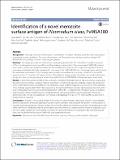Identification of a novel merozoite surface antigen of Plasmodium vivax, PvMSA180
Abstract
Background: Although a number of Plasmodium vivax proteins have been identified, few have been investigated as potential vaccine candidates. This study characterized the Plasmodium vivax merozoite surface antigen 180 (PvMSA180, PVX_094920), a novel P. vivax antigenic protein. Methods: The target gene was amplified as four overlapping domains (D1, D2, D3 and D4) to enable expression of the recombinant protein using cell-free and bacterial expression systems. The recombinant PvMSA180 proteins were used in protein microarrays to evaluate the humoral immune response of 72 vivax-infected patients and 24 vivax-naive individuals. Antibodies produced in mice against the PvMSA180-D1 and -D4 domains were used to assess the subcellular localization of schizont-stage parasites with immunofluorescence assays. A total of 51 pvmsa180 sequences from 12 countries (41 sequences from PlasmoDB and 6 generated in this study) were used to determine the genetic diversity and genealogical relationships with DNAsp and NETWORK software packages, respectively. Results: PvMSA180 consists of 1603 amino acids with a predicted molecular mass of 182 kDa, and has a signal peptide at the amino-terminus. A total of 70.8% of patients (51/72) showed a specific antibody response to at least one of the PvMSA180 domains, and 20.8% (15/72) exhibited a robust antibody response to at least three of the domains. These findings suggest that PvMSA180 is targeted by the humoral immune response during natural infection with P. vivax. Immunofluorescence analysis demonstrated that PvMSA180 is localized on the merozoite surface of schizontstage parasites, and pvmsa180 sequences originating from various geographic regions worldwide showed low genetic diversity. Twenty-two haplotypes were found, and haplotype 6 (Hap_6, 77%) of pvmsa180 was detected in isolates from six countries. Conclusions: A novel P. vivax surface protein, PvMSA180, was characterized in this study. Most of P. vivax-infected patients had specific antibodies against particular antigenic domains, indicating that this protein is immunogenic in naturally exposed populations. Genetic analysis of worldwide isolates showed that pvmsa180 is less polymorphic than other well-known candidates and that some haplotypes are common to several countries. However, additional studies with a larger sample size are necessary to evaluate the antibody responses in geographically separated populations, and to identify the function of PvMSA180 during parasite invasion.
Citation
Muh , F , Han , J-H , Nyunt , M H , Lee , S-K , Jeon , H-Y , Ha , K-S , Park , W S , Hong , S-H , Ahmed , M A , Na , S , Takashima , E , Tsuboi , T & Han , E-T 2017 , ' Identification of a novel merozoite surface antigen of Plasmodium vivax , PvMSA180 ' , Malaria Journal , vol. 16 , 133 . https://doi.org/10.1186/s12936-017-1760-9
Publication
Malaria Journal
Status
Peer reviewed
ISSN
1475-2875Type
Journal article
Collections
Items in the St Andrews Research Repository are protected by copyright, with all rights reserved, unless otherwise indicated.

